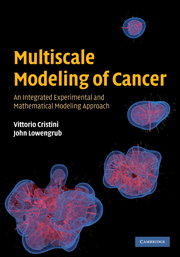Book contents
- Frontmatter
- Contents
- List of contributors
- Preface
- Acknowledgements
- Notation
- Part I Theory
- 1 Introduction
- 2 Biological background
- 3 Continuum tumor modeling: single phase
- 4 Analysis and calibration of single-phase continuum tumor models
- 5 Continuum tumor modeling: multiphase
- 6 Discrete cell modeling
- 7 Hybrid continuum–discrete tumor models
- 8 Numerical schemes
- Part II Applications
- References
- Index
3 - Continuum tumor modeling: single phase
from Part I - Theory
Published online by Cambridge University Press: 05 October 2010
- Frontmatter
- Contents
- List of contributors
- Preface
- Acknowledgements
- Notation
- Part I Theory
- 1 Introduction
- 2 Biological background
- 3 Continuum tumor modeling: single phase
- 4 Analysis and calibration of single-phase continuum tumor models
- 5 Continuum tumor modeling: multiphase
- 6 Discrete cell modeling
- 7 Hybrid continuum–discrete tumor models
- 8 Numerical schemes
- Part II Applications
- References
- Index
Summary
Introduction
We present a sharp-interface continuum model of tumor growth, in which the tumor is treated as a single-phase, or piecewise single-phase, biomaterial with sharp boundaries delineating the various tumor components (viable, quiescent, and necrotic cells). We present the model in order of increasing complexity, starting with avascular and vascular versions that incorporate varying degrees of microenvironmental heterogeneity and ending with a model that accounts for the nonlinear coupling between tumor growth and tumor-induced angiogenesis. In this chapter we focus on the presentation of the model. Analysis and numerical simulations are presented in Chapter 4.
Background
In larger-scale systems, continuum methods provide a good modeling strategy. The reader should refer to the Introduction (Chapter 1) for references and reviews on the continuum modeling of cancer. The approach draws upon principles from continuum mechanics to describe variables as continuous fields described by means of partial differential and integro-differential equations, and it allows for the development of fast numerical solvers. These models treat a tumor as a collection of tissue, for which densities or volume fractions of cells are described. Individual cells and other discrete elements are not tracked. The model parameters may describe volume fractions of various cell species as well as concentrations of cell substrates such as glucose, oxygen, and growth factors. On the one hand, the parameters at this macro-scale are somewhat easier to obtain, analyze, and control compared with those required for discrete models, which typically involve cellular and subcellular measurements (see Chapter 6).
- Type
- Chapter
- Information
- Multiscale Modeling of CancerAn Integrated Experimental and Mathematical Modeling Approach, pp. 24 - 40Publisher: Cambridge University PressPrint publication year: 2010

